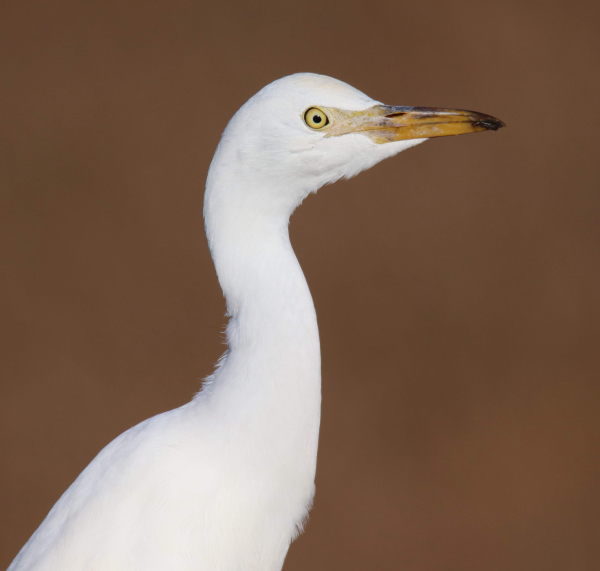
An uncommon encounter with a pair of Cattle Egrets south of the border provided a chance to observe the birds and take a series of photos.
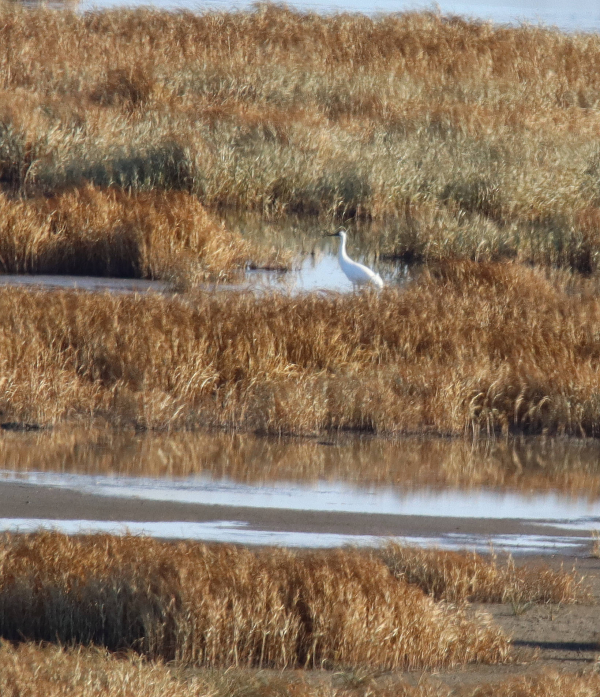
A white dot in the distance documented a rare chance to observe and photograph an adult Whooping Crane, along with its mate and young of the year during a migration stopover last Wednesday.
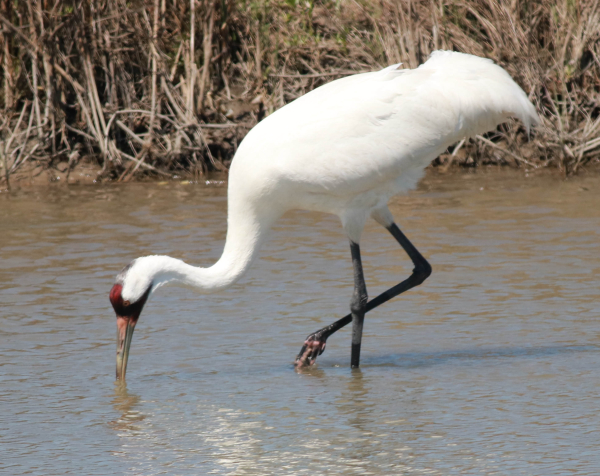
A close photo of an adult Whooping Crane is nearly impossible during migration, but you can learn more about photographing Whoopers in the Bird Photography feature in this issue.
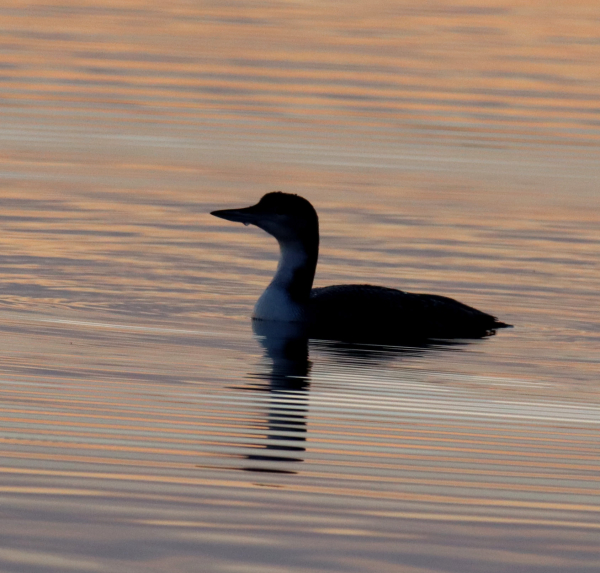
After missing for 8 days, another sighting of the young Common Loon was a welcome surprise at sunset Saturday.
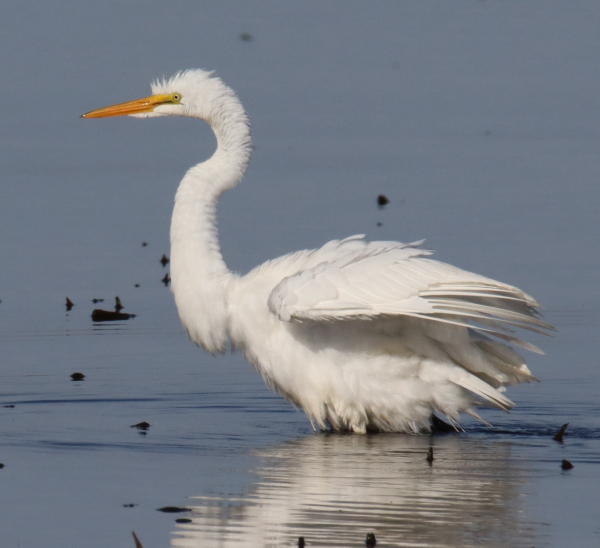
A bathing Great Egret yielded a series of photos that ended with a feather ruffling action.
|
Whooping Cranes! A family of Whooping Cranes! Rare as a comet, there they were, landing before me – an adult pair with their young but full-sized cinnamon and white colored juvenile. Alighting on the edge of a shallow wetland broken by cattails, the Whoopers separated more and more as they immediately began foraging. I watched the super-rare birds from more than a quarter-mile away, taking photographs periodically, even though the birds showed up as little more than white dots on the northeast edge of an area known as Glencoe Bottoms, a low floodplain marsh adjacent to the Missouri River south of Bismarck.
During the hour or so that I observed the Whoopers, they simply waded through an area of shallow water, holding their neck, head, and bill pointed downward so their body was in a mostly horizontal position as they walked slowly; the adults periodically standing upright, probably to make sure all was well with the world. Toward the end of my observations, the cranes regrouped together to preen and loaf, and after a period I decided I should carry on. While the cranes’ behaviors were simplistic, the birds themselves were dramatically exciting and just having the opportunity to spend time within view of such spectacular birds was a special event – they always command my attention while providing a unique thrill as the tallest birds in North America, as well as one of the rarest species.
The chances of finding a Whooping Crane during migration are astronomical considering the wide swath of land where Whooping Cranes have been sighted – a few hundred miles wide and a few thousand miles between their small nesting range in and around Wood Buffalo National Park on the border of Northwest Territories and northeast Alberta; and their wintering range in and around Aransas National Wildlife Refuge on the Gulf Coast of Texas. Whoopers tend to begin their migration in a southeast direction with a stopover in southern Saskatchewan, then continue their migration flights through central or western North Dakota, turning directly south through the Great Plains states from the Dakotas to Texas with more migration stops along the way.
In North Dakota, the Missouri River is a major migration corridor that cranes, geese, ducks, raptors, and many other birds follow, and the Glencoe Bottoms area is one of the most likely locations where Whooping Cranes might stopover. In fact, I observed another family group there some years ago, so that location has produced 2 of the 5 sightings I’ve had of Whoopers during migration, including 2 of the 3 family groups I have seen during migration stopovers.
Considering how many miles I travel each fall and spring across Whooper migration lands, I have always relied on other people’s sightings and information from a birder or biologist about their position. But even when a Whooping Crane sighting location is provided, I’ve searched in vain for plenty of Whoopers without finding them; they can continue their migration before I get there, or be repositioned out of sight during my search – you never know. But for some reason, I didn’t have a moment of hesitation or doubt that I would find the cranes 2 hours down the road last Wednesday.
I will admit that observations of the great white cranes at that long distance are not the most fulfilling – you always want to be closer, especially to photograph them. But they are an endangered species and as a photographer you want to make sure the birds aren’t disturbed. Migrating Whooping Cranes are famous for being especially wary, picking out remote stopover locations, either open marshes or agricultural fields where they can see for a mile or more in each direction. But I knew what to expect, and I was thrilled to have the rare family of cranes to myself on an almost windless blue sky fall afternoon.
However, there is a place and a means to photograph Whoopers within fairly close quarters: You can observe and photograph Whooping Cranes along the Gulf Coast in Texas, where some become habituated to boat traffic adjacent to the coastal marshes where they spend winters. For more about that, and photographing Whooping Cranes in general, see this week’s Bird Photography feature at the end of this issue.
Periodically, as a biologist I specialize in studying crane populations, and my crane research has taken me to many remote areas of several continents, working in concert with biologists in the nations Zambia, South Africa, Botswana, China, India, Canada, and the United States to study 10 of the world’s 15 crane species professionally. During field trips while promoting birding or while leading birding expeditions, I also observed cranes in Australia, Germany, Israel, Russia, and Kenya. Cranes have definitely fueled some memorable periods of my life, and to see a super-rare family group of Whooping Cranes near my hometown, I was pretty thrilled! So much so that I alerted a long list of friends, family, and associates about my good fortune.
Coteau Drive & Refuge Destination
During my 2-hour Whooping Crane journey across the Missouri Coteau, I passed a few big flocks and individual birds, including local flocks of 600 and 200 Snow Geese, peppered with smaller Ross’s Geese, 7 Tundra Swans, about 70 Canada Geese, a Great Blue Heron, and a few American Avocets, and a variety of ducks. The next hotspot was an hour away, a big lake where I encountered roughly a thousand Snow Geese with about 60 Tundra Swans assembled. Aside from that, birds were widespread and pretty predictable, including 4 Red-tailed Hawks, a Northern Harrier, and a flock of about 40 Canada Geese.
Actually, immediately after leaving the Whooping Cranes, I sighted a dark-colored Red-tailed Hawk, which I verified to be a dark morph Harlan’s Red-tail, the first of fall I’ve seen down from somewhere in the Northwest – somewhere between Alberta and Alaska. These black Harlan’s are not common and always a treat to see; this one appeared to be a first-year female with black or dark-gray tail feathers that were pretty obvious when in flight, soaring ever-higher overhead.
Other Missouri Slope birds included 3 more Red-tailed Hawks, 2 separate Bald Eagles, 1 Northern Harrier, a lone Wild Turkey, a flock of 36 Wild Turkeys, 2 Black-billed Magpies, and 5 Ring-necked Pheasants. My next destination was Long Lake National Wildlife Refuge, where the first birds to fly into view were flocks of Sandhill Cranes, totaling about a 60 Sandhills in a half-dozen flocks after leaving the lake edge to feed in a harvested ag field a few miles to the west. Their low flights and loud calls were exhilarating, especially when I realized that this would be one of the few days I would be lucky enough to see both of North America’s crane species within an hour.
Tundra Swans and Snow Geese at the refuge kept a distant profile without taking wing during my survey of the west side of the elongated refuge, but I did see a few late Western Grebes, flocks of Canada Geese, Northern Shovelers, Green-winged Teal, Gadwalls, and Mallards. Ring-necked Pheasants were scattered around the area, but it was surprising to see a refuge road “covered” by an especially large flock that numbered at least 35 birds in the open, with more hiding in adjacent cover I’m sure.
New Birds from the Arctic
After an expansive local birding drive Thursday, it was revealing to find new species during another exploratory drive Friday, which indicated a movement of birds into the area overnight or that morning. The most exciting was the first of fall Rough-legged Hawk, and there were also 3 flocks of Lapland Longspurs, each numbering about 50. A flock of about 40 Cackling Geese mixed in with a like number of White-fronted Geese – the first of the season – along with about 60 Snow Geese and another 60 Canadas; separate but near the big flock of Snow Geese and Ross’s Geese that’s been steadily increasing to more than a thousand in the long lake less than 2 miles north.
In other areas I oberved 2 other flocks of Snow Geese numbering in the hundreds, but located too far away to estimate their numbers. A Bald Eagle and 3 solo Red-tailed Hawks preceded 5 Northern Harrier sightings, and there were flocks of 35 and 11 Tundra Swans, a pair of Ring-necked Pheasants, 3 American Avocets, 2 Greater Yellowlegs, and a Great Blue Heron. Other birds included a flock of Double-crested Cormorants swimming together to corral fish with Ring-billed Gulls circling and diving from overhead when they sighted fish in the midst of the cormorant action.
Sand Lake Excitement
I couldn’t hold back Saturday, even with a partly cloudy sky predicted, but that weather forecast was off as blue sky fueled my drive to Sand Lake National Wildlife Refuge, across the border in the southern Dakota. But before I made the turn east, the first raptor looked a bit suspicious, so I pulled over to use my binoculars to reveal a beauty of a Prairie Falcon – a great way to start a big afternoon of birding. I took a couple photos of the queen perched and was on my way again.
The next birds to make me stop weren’t rare, but I rarely get a chance to photograph them, and now that I think of it, I don’t see them very often – it was a pair of Cattle Egrets, usually found in flocks at this time of year, but just a pair now. As I positioned my car for photos the egrets resumed their hunt, feeding on chilly grasshoppers gleaned from the grass as I photographed them as they sometimes closely approached my position.
Sand Lake was beautiful, drier than during my last visit in August, and it was obvious birds were in early migration mode, with few geese, many ducks, and scattered other birds. But the falcon and the egrets already alerted me that it just takes a bird or 2 to provide special moments and interesting photographs, so I continued my search through the expansive refuge and beyond. Ducks and coots were the dominant birds, with a few small flocks of mid-sized Canada Geese close; the big flocks of Snows and presumably Ross’s Geese were a half-mile beyond access; no big deal, but it’s always fun to be closer to the flocks.
The best photo option came from the only Great Egret of the day, notable because it was bathing, providing some action photos as it stood in deepish water that was glassy until the egret dipped low so most of its body was submerged a few times, then ruffling the water drops off, waiting a moment and repeating the process. Of course, I was photographing the action, but I was also anticipating the bird would raise up and flap its wings – like most birds would – but that never happened. I don’t know that I’ve ever watched an egret bathe before, and that’s part of the reason I photographed it; plus it was a great opportunity to engage in a level of action photography.
Other notable birds in the refuge and beyond during my full afternoon drive included 5 Bald Eagles, 7 Red-tailed Hawks, 8 Northern Harriers, and 2 more falcons – or should I say mini-falcons – 1 Merlin flying then diving over the refuge marsh, and a second Merlin in flight just as we both crossed the border from South to North Dakota. There were also 3 late Western Grebes, 2 Great Blue Herons, 7 Ring-necked Pheasants, and the usual variety of ducks.
After returning to my office just as the sun was setting, I extended my drive 3 miles north, and on my return, I caught sight of the silhouette a single large duck-like bird – it was the young Common Loon! It was diving for fish in the same lake as I found it 8 days earlier, albeit 2 miles north of its initial location. As it dived before me, fairly close but merely a silhouette, I waited for it to surface atop the sunset-colored water. I watched a couple more dives, then headed for home; but I would definitely resume regular searches for it along the 3-mile-long lake, which was also harboring more than a thousand geese, including 5 species now: Snows, Ross’s, Canadas, White-fronted, and Cackling Geese.
Northwest Cruise
Sunday I traveled along my raptor route to the west and northwest, which quickly reached a high level of excitement less than 2 miles into the drive. A mini-falcon was perched on top of the highest tree on a prominent hilltop; tipping its tail, my first thought was that this was an American Kestrel, but a quick look through my zoom lens showed it was another brown Merlin – either an adult female or first-fall Merlin. I took a couple documentary photos before the falcon began a brisk flight in my general direction, zooming by broadside for a series of photos that didn’t show as sharp as I hoped they would – hmm – tough to autofocus on a speedster like that Merlin is my guess.
As with my other regional drives during the week of fine fall weather, bird sightings were widely spaced; however, I did find 4 big concentrations of Snow Goose-dominated flocks, 2 of which numbered more than a thousand geese. Each of the goose gatherings also had a few Tundra Swans associated on an edge of the flocks. I’m still waiting for chances to photograph swans this fall, but to date they haven’t been very aerial, and they have always been positioned far off in the distance on the edge of big lakes.
The other special sighting during this birding drive was a flock of about 10 Gray Partridges, likely a family group, that flushed from the roadside and gave me some distant views as they walked into cover after landing. I haven’t seen partridges for quite a while, so this sighting alerted me to be on the lookout for them as fall progresses. Ducks were widespread, mostly Mallards, Northern Shovelers, and Green-winged Teal – plus a small flock of Buffleheads that stood out from the crowd. While there seem to be many more Green-winged Teal in the region this fall, I now realized that Blue-winged Teal vacated a couple weeks ago, as did American Wigeons.
My raptor count was sparse after the Merlin, with only a male Northern Harrier and 3 Red-tailed Hawks sighted. I did check out a feeding Red-tail for a bit, and after it took flight from its ground-based feeding locale, I walked over to see what prey it had eaten. I was surprised to find the tail of a salamander, almost the last animal I would have expected a hawk to feed on, but it underlined that Red-tails have an almost universal prey base, as long as the animals are smaller than the birds themselves. Of course, I checked for the Common Loon on the big lake north of my office 4 times during the course of the day, hoping to relocate it, but it didn’t leave a trace. Perhaps it flies to another of the big lakes nearby, perhaps it keeps a low profile underwater during my searches, but I’ll continue to watch for it, but maybe not 4 times per day – ha.
Out My Windows
A Purple Finch was the only new species to appear at my feeding station last week (Monday), but most of the birds remained from the week before, except the Red-breasted Nuthatches. I’m always very happy to see the Blue Jays and Harris’s Sparrows, White-breasted Nuthatches, Downy and Hairy Woodpeckers, and House Finches up close as they visit my feeders and bird bath, along with a couple Dark-eyed Juncos and White-throated Sparrows on the ground below.
It was obviously a tremendous week of rarely encountered birds including Whooping Cranes, a Common Loon, a dark-morph Harlan’s Red-tailed Hawk, a Prairie Falcon, 3 Merlins, a flock of Gray Partridges, a colorful Purple Finch, and the first of fall White-fronted Geese – lots of exciting migrants plus partridges; not to mention big concentrations of Snow Geese and flocks of Tundra Swans. I’m excited to see what birds appear next, and how many more thousands of waterfowl will follow as the new month kicks in. Enjoy this first week of November and the birds that keep it lively.
Article and photos by Paul Konrad
Share your bird sightings and photographs at editorstbw2@gmail.com